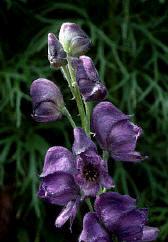 Common Name: Monkshood Family: Ranunculaceae Introduction: Acontie is commonly indicated in acute conditions especially in young plethoric persons who lead a sedentary life, who are easily affected by atmospheric change. Causation: The complaints of aconite patient are caused by exposure to dry cold air, dry north or west winds, or exposure to draughts of cold air during perspiration. Generalities: Pains of the aconite patient are very intense. So intense that patient becomes restless and tosses in agony. Pains are unbearable and are usually worse at night. Mind: Fear, Restlessness and Agony are most marked. Fear of death. Patient predicts the day of the death. Fear of crowd, of crossing streets. Thinks that his disease ultimately leads to death.Great restlessness especially at night. Changing the position very often. Cannot bear music, makes sad. Respiratory: Croup;Dry, hoarse, suffocating cough which is excited on expiration. Cough from exposure to drafts of cold air. Female: Amenorrhoea in plethoric young girls due to fright. Fever: One of the important and often employed remedy in fevers, especially in congestive stage of inflamatory conditions. Fever accompanied with restlessness and intollerable pains. Skin dry and hot with burning thirst for large quantities of cold water. Aggravation: Condition Worse in evening and Night, in warm room; during pains; when rising from bed, because of fear of fainting; lying on affected side. Amelioration: Feels better in open air. Relationship: Aconite is acute of Sulphur. Both preceed and follow each other in acute conditions. Aconite is complementary to Coffea(in fever,pains); to Arnica(in traumatism); to Sulphur in all conditions. |